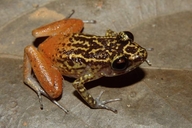|
Description
Adult size is small, reaching only 25 mm SVL in females and 21 mm SVL in males. The dorsum, throat and belly are smooth; the belly disc is poorly developed. The digital discs are small. There is no webbing between the toes. The vomerine teeth, behind the choanae, are in long and almost straight series (Schwartz 1960; Schwartz and Henderson 1985; Schwartz and Henderson 1991).
The anterior surface is yellowish tan, grading rapidly behind the sacral region to orange, reddish brown or rich mahogany on the posterior third of the dorsum and the upper surface of the hind limbs. The anterior two-thirds of the dorsum and the upper surface of the forelimbs are overlaid with black markings that almost entirely mask the ground color. These markings extend over the lores and snout and ventrally to a line on each side connecting fore and hind limbs. Two very faintly and irregularly delimited dorsolateral lines are apparent. The dark dorsal markings degenerate into isolated black and gray marks on the posterior third of the dorsum, as well as the thighs and crura. The concealed surfaces of the hind limbs are dark brown. The venter is covered with a regular arrangement of brown chromatophores, giving it a dark appearance (Schwartz 1960; Schwartz and Henderson 1985; Schwartz and Henderson 1991). Distribution and Habitat
Country distribution from AmphibiaWeb's database: Cuba
This species is endemic to Cuba and it is known only from Sagua-Baracoa and the Sierra Maestra Mountains, Guantánamo Province, eastern Cuba, at 30-1,150 m asl. This is a terrestrial frog sometimes found in shrubs (60 cm above the ground) and always in very moist areas of humid forests (Schwartz 1960; Schwartz and Henderson 1991).Life History, Abundance, Activity, and Special Behaviors
The call generally consists of 1-2 notes, followed by trills of 10-15 notes. The notes of all calls have a rising frequency modulation. Various trills may be emitted consecutively. Call repetition rate is 43-48 calls/minute. Note duration is 11-34 milliseconds and trill duration is 481-752 milliseconds. The call interval is 0.3-4.2 seconds. The mean dominant frequency of a note is 3.5 kHz (range 2.4-3.9 kHz) and the mean dominant frequency of the trills is 4.3 kHz (range 3.8-4.9 kHz) (Díaz and Cádiz 2007).
This species has terrestrial eggs with direct development (Stuart et al. 2008). Trends and Threats
Eleutherodactylus acmonis is declining and is not common even where habitat is suitable (Stuart et al. 2008). Habitat modification is considered the principal threat to this species (Vale et al. 1998). Habitat loss is an issue as well, arising from deforestation due to subsistence agriculture and charcoal collection (Stuart et al. 2008). In addition, habitat degradation and loss are also due to increased infrastructure development for tourism (Stuart et al. 2008). E. acmonis does occur within several protected areas but management needs to be strengthened (Stuart et al. 2008). Possible reasons for amphibian decline General habitat alteration and loss
Habitat modification from deforestation, or logging related activities
Intensified agriculture or grazing
Comments
This species is a member of the Eleutherodactylus ricordii group (subgenus Euhyas) (Hedges et al. 2008).
References
Díaz, L. M. and Cádiz, L. M. (2007). ''Guía descriptiva para la identificación de las llamadas de anuncio de las ranas cubanas del género Eleutherodactylus (Anura: Leptodactylidae).'' Herpetotropicos, 3, 100-122.
Hedges, S. B., Duellman, W. E., Heinicke, M. P. (2008). ''New World direct-developing frogs (Anura: Terrarana): Molecular phylogeny, classification, biogeography, and conservation.'' Zootaxa, 1737, 1-182.
Schwartz, A . and Henderson, R. W. (1985). A Guide to the Identification of the Amphibians and Reptiles of the West Indies Exclusive of Hispaniola. Milwaukee Public Museum, Milwaukee.
Schwartz, A. (1960). ''Nine new Cuban frogs of the genus Eleutherodactylus.'' Science Publishers Reading Public Museum Art Gallery, 11, 1-50.
Schwartz, A. and Henderson, R. W. (1991). Amphibians and Reptiles of the West Indies: Descriptions, Distributions and Natural History. University Press of Florida, Florida.
Stuart, S., Hoffmann, M., Chanson, J., Cox, N., Berridge, R., Ramani, P., Young, B. (eds) (2008). Threatened Amphibians of the World. Lynx Edicions, IUCN, and Conservation International, Barcelona, Spain; Gland, Switzerland; and Arlington, Virginia, USA.
Vale, M., Alvarez, A., Montes, L., and Avila, A. (1998). Estudio Nacional sobre la Diversidad Biológica en la República de Cuba. CESYTA, Madrid.
Originally submitted by: Ansel Fong G. (first posted 2004-10-18)
Edited by: Kellie Whittaker (2009-12-13)Species Account Citation: AmphibiaWeb 2009 Eleutherodactylus acmonis: Cuban Red-rumped Frog <https://amphibiaweb.org/species/2748> University of California, Berkeley, CA, USA. Accessed May 12, 2025.
Feedback or comments about this page.
Citation: AmphibiaWeb. 2025. <https://amphibiaweb.org> University of California, Berkeley, CA, USA. Accessed 12 May 2025.
AmphibiaWeb's policy on data use.
|
